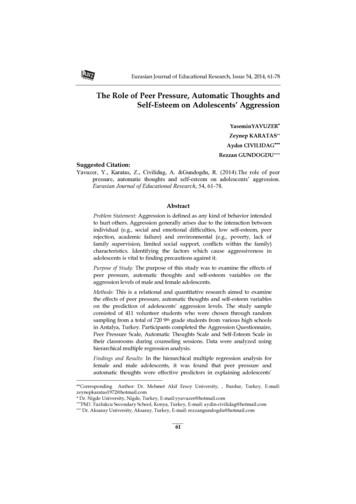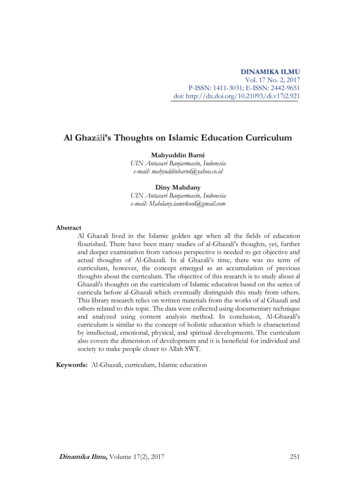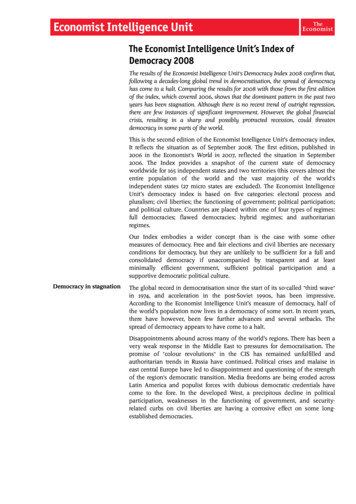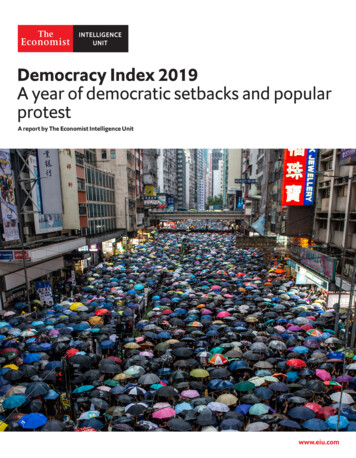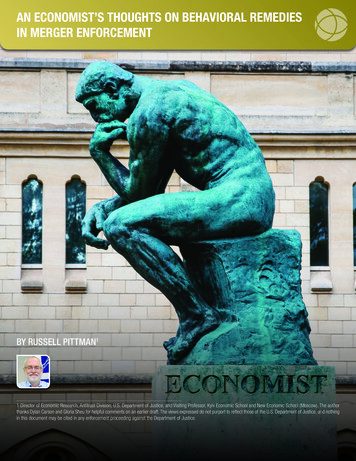
Transcription
AN ECONOMIST’S THOUGHTS ON BEHAVIORAL REMEDIESIN MERGER ENFORCEMENTBY RUSSELL PITTMAN11 Director of Economic Research, Antitrust Division, U.S. Department of Justice, and Visiting Professor, Kyiv Economic School and New Economic School (Moscow). The authorthanks Dylan Carson and Gloria Sheu for helpful comments on an earlier draft. The views expressed do not purport to reflect those of the U.S. Department of Justice, and nothingin this document may be cited in any enforcement proceeding against the Department of Justice.
CPI ANTITRUST CHRONICLEAPRIL 2020CPI Talks with Isabelle de SilvaConduct Remedies, With 2020 Hindsight:Have We Learned Anything in the LastDecade?By John E. KwokaEconomic Democracy and Market PowerBy Zoë Hitzig, Michelle Meagher,André Veiga & E. Glen WeylBehavioral Remedies in U.S. MergerSettlements: Past, Present and FutureBy Julie A. North & Jesse M. WeissDefining Remedy SuccessThere is by now a substantial literature examining the experience in boththe United States and the European Union with the imposition by enforcement agencies of remedies as a condition for a merger to proceed without challenge.2 Increased recent interest may have been encouraged byboth the refusal of the Antitrust Division of the Justice Department (“DOJ”)to accept a settlement offer in the AT&T/Time-Warner merger litigationthat was arguably similar to that accepted by DOJ and FCC in the earlierComcast/NBCU merger;3 the announcement by the DOJ that it was withdrawing its 2011 Policy Guide to Merger Remedies, returning to the 2004guide until a “review” leads to an “updated” policy;4 and the litigation inthe Southern District of New York that encompassed the consent decreeaccompanying the recent T-Mobile/Sprint merger.5The broad goals of the agencies have arguably remained consistentover the years: to allow mergers to take place that will achieve efficiencygains, while preventing harm to competition, and to protect the integrity ofthe competitive process in the relevant markets as opposed to seeking todictate particular outcomes.In addition, a number of more specific “lessons” of the past – fromfailures as well as successes – seem to have become broadly acceptedin recent years:By F. David Osinski Structural remedies are generally preferred over behavioral remedies;Non-Self-Enforcing Remedies and theRecent Modification to the Ticketmaster/Live Nation Merger Consent Decree Structural remedies should where possible include the divestitureof complete existing “business units” rather than seeking to assemble a package from various assets from one or both firms, evenif some portions of the business units are not part of the competitive problem;6Remedies: Structural, Behavioral, Both,or None? Enforcement Trade-Offs forMergers and Antitrust Nevertheless, structural remedies may sometimes need to be supported by behavioral measures if only as a transition mechanism;7By Mary T. Coleman & David A. WeiskopfBy Andreea Cosnita-Langlais2 See, most recently, Christopher A. Wetzel, Strict(er) Scrutiny: The Impact of Failed Divestitures on U.S. Merger Remedies, 64 Antitrust Bull. 341 (2019).Structural vs. Behavioral Remedies3 Angeline Woods & Jenn Mellott, Merger Remedies in the EU and U.S.: Lessons fromRecent Practice, 33 Antitrust 59 (2019).By Frank Maier-Rigaud& Benjamin LoertscherAn Economist’s Thoughts on BehavioralRemedies in Merger EnforcementBy Russell PittmanStructural vs. Behavioral Remedies inBig Tech SectorsBy Francesco Ducci & Michael TrebilcockVisit www.competitionpolicyinternational.com foraccess to these articles and more!CPI Antitrust Chronicle April ion Policy International, Inc. 2020 Copying, reprinting, or distributingthis article is forbidden by anyone other than the publisher or author.4 Makan Delrahim, “It Takes Two: Modernizing the Merger Review Process,” Remarks at the2018 Global Antitrust Enforcement Symposium, Georgetown University Law Center, September 25, 2018, available at lobal-antitrust.5 See State of New York, et al., v. Deutsche Telekom AG, et al., Decision and Order, February11, 2020, and United States, et al., v. Deutsche Telekom AG, et al., Competitive ImpactStatement, 9501/download.6 “In evaluating the remedy, the United States recognized that fully preventing the competitive effects of a merger in some cases requires the inclusion of assets or projects thatare beyond the affected relevant markets.” U.S. v. Bayer, Monsanto, and BASF, CompetitiveImpact Statement, at 16.7 “Because many of the divested assets will be separated from Bayer’s existing businessunits and incorporated into BASF, the proposed Final Judgment includes provisions aimedat ensuring that the assets are handed off in a seamless and efficient manner . Thetransition services and interim supply agreements are time-limited to ensure that BASF willbecome fully independent of Bayer as soon as practicable.” Ibid. at 17.2
The merging firms have clear incentives to seek buyers and/or to package assets in such a way as to create a weak competitor goingforward; thus The agencies must take care that buyers have both the experience and the financial capability to manage the divested assets successfully, as well as ensuring that the assets are not allowed (or encouraged) to deteriorate in quality during the process of negotiation anddivestiture.8However, as usual, the devil is in the details, and some of these “lessons” merit a closer look, especially in light of recent developments in bothscholarship and jurisprudence. In particular, I will argue in this short article that behavioral remedies may be even more complex and raise morecomplicated economic issues than has been previously appreciated, so that there is perhaps even more reason than already understood foragencies to resist their surface allure.Begin with the structural/behavioral distinction. Structural remedies – the divestiture of particular assets of one or (less often) both of themerging parties – are generally favored because they seek to protect the competitive process itself: to rely on the profit-maximizing incentivesof the firms in the post-merger market to maintain competition, with the standard benefits of Adam Smith’s invisible hand to follow. Behavioralremedies – also called “conduct remedies” – on the other hand, seek to force the merged firm to behave in ways that it may not find profit-maximizing: most often, to force it to supply a particular good or provide access to a particular asset to competitors, when its profits might be higher ifit could decline to do so. Thus, behavioral remedies generally require continued monitoring of the behavior of the merged firm by an agency and/or a court – an activity that neither the agencies nor the courts are generally well equipped to perform, a fortiori if they are monitoring behavioralremedies from other mergers at the same time. Furthermore – as with structural remedies – the merging firms are likely to recognize the limitsof the agencies and courts in their monitoring abilities, and so to propose and/or to agree to particular remedial arrangements accordingly.Behavioral remedies have nevertheless been sought and accepted by the U.S. (and EU) enforcement agencies in settings where the contentions of overall benefits of the merger were accepted, but structural remedies would significantly lessen or destroy those benefits. This hasbeen the case predominantly with proposed vertical mergers as well as with proposed horizontal mergers in markets where intellectual propertyis a central concern.9A not uncommon example of a behavioral remedy was the set of provisions of the consent decree (2013) in the Comcast/NBCU merger.As a condition of regulatory and enforcer approval of this vertical merger between a programmer (NBCU) and a distributor (Comcast), the mergedfirm agreed to multiple requirements related to the non-discriminatory provision of NBCU content to rival distributors. These included the requirements that the merged firm supply video programming to any OVD (online video provider) both on terms “economically equivalent” to the termson which it supplies programming to any MVPD (multichannel video programming distributor, i.e. other cable and satellite distributors) and onterms economically equivalent to those that the OVD receives from other programmers. The term “economically equivalent” was specified to takeaccount of, “among other things,” differences in advertising revenues, legal rights, and minimum subscriber and penetration rates (in the formercase) and differences in the value of the programming (in the latter case).10In this particular matter, of course, the agency (DOJ) and the court could take advantage of the expertise and resources of the regulator(FCC) in monitoring future transactions in order to prevent discrimination against non-vertically-integrated distributors. Nevertheless the meresummation of the terms of the consent decree makes clear the potential for future disputation over the terms of future supply agreements,beginning with the fact that the decree defines “economically equivalent” as meaning “the price, terms, and conditions, that, in the aggregate,approximate those” in the comparator transactions, and moving into the question of how, exactly, those terms are to “take account of” the additional factors enumerated. In the event, the FCC docket of post-merger related proceedings is quite extensive.118 See, for example, U.S. Department of Justice, Antitrust Division Policy Guide to Merger Remedies (2004), load.9 See, e.g. Scott Sher & Kellie Kemp, A Comparative Analysis of the Use of Merger Remedies in Technology Industries, 14 CPI Antitrust Chronicle. 1 (2014); Benjamin Loertscher& Frank Maier-Rigaud, On the Consistency of the European Commission’s Remedies Practice, presented at 14th annual conference of the GCLC, Brussels, 2019, and Wetzel,supra note 2.10 U.S., et al., v. Comcast, General Electric, and NBC Universal, Modified Final Judgment, at 9-14.11 See s name 10-56&sort date disseminated,DESC and, for example, the most recent lengthy statement of the mergedfirm of its Annual Report of Compliance with Transaction Conditions, %20Report%20(2018-01-29).pdf. In addition, some disputes reportedly were submitted for private arbitration and so not publicly announced.CPI Antitrust Chronicle April ion Policy International, Inc. 2020 Copying, reprinting, or distributingthis article is forbidden by anyone other than the publisher or author.3
In addition, note that any requirement of non-discrimination raises the question of how the set of provisions that will act as comparators for the new arrangements are determined. To the degree that non-discrimination requirements reference contracts previously signed andarrangements previously put into place, so far, so good; however, contracts and arrangements change over time, and if – for example – a lowcurrent price to some customers limits the supplier’s ability to raise prices on others, that may provide an incentive for the firm to raise the priceto the former. In other words, a non-discrimination requirement aimed at protecting one set of customers may, all else equal, act to harm another– and, in that respect, be ineffective in protecting the former.Arguably, similar issues were raised by the non-discrimination provisions in a number of other consent decrees. For example: The FTC consent order (2001) in the AOL/Time Warner merger, which required the merged firm (a) to enter into cable broadband internetservice provision agreements with non-affiliated internet service providers (“ISPs”) under various circumstances “on terms comparableto” agreements with other non-affiliated ISPs or major cable providers, and (b) to offer DSL service to customers in geographic areasserved by its affiliates “at retail pricing, terms, and conditions that are the same or comparable to” those in areas not served by its affiliates, “provided, however, that [the merged companies’] pricing may reflect any actual differences in Costs” (sic; emphasis in original). The FTC consent order (2007) in the United Launch Alliance (“ULA”) of Lockheed Martin (“LM”) and Boeing, which required the jointventure and its parent companies to behave in a non-discriminatory manner toward competitors of the joint venture and competitors ofthe “space vehicle business” of the parent companies, where discrimination was defined as to “advantage Boeing or LM or disadvantagea competitor of Boeing or LM [or] to advantage ULA or disadvantage a competitor of ULA provided, however, that the determinationof compliance or non-compliance with the non-discrimination provisions of this Order shall take into account that different firms will takedifferent competitive approaches that may result in differences in price, schedule, quality, data, personnel, investment , technology,innovations, design, and risk.” The DOJ-negotiated consent decree (2011) in the Google/ITA Software merger, which required the merged firm to offer ITA’s airfarepricing and shopping engine QPX to non-airline-affiliated “online travel intermediaries” (“OTSs”) on “commercial terms (e.g. price, functionality, minimum query volumes and permitted uses of QPX, as well as customization and query tuning services for QPX) that were “fair,reasonable and non-discriminatory judged exclusively in relation to the OTI’s chosen contract term, desired fee metrics (e.g. per-query,per-ticket, or per-[Passenger Name Record]), reasonably expected query volume, the minimum query volume to be included in such QPXAgreement, and the commercial terms of QPX Agreements in effect between [the merged firm] and Similarly Situated OTIs” – where“Similarly Situated OTIs” has its own multiline definition.An additional complication arises when a behavioral decree prohibits a firm from discriminating in its supply of a product to a competitorvis-à-vis the terms on which it supplies itself – its internal price. Such decree provisions raise the frequently noted difficulty of attaching meaningto the prices assigned to internal firm transfers – “transfer prices” – which may be affected by tax, regulatory, international trade, and otherfactors that render such prices less than meaningful as proxies for actual market transactions.12 In addition, as with the previously analyzedprovisions, a requirement that a firm sell a product to outsiders at the same price that it transfers it internally in principle provides an additionalincentive for the firm to set transfer prices strategically. The FCC recognized this issue in both its Comcast/NBCU and News/Hughes decisions,noting in the former that “To facilitate the combined entity’s exercise of a uniform-price-increase strategy, Comcast could pay the same [transfer]fees as its MVPD rivals or could choose to pay the highest fee that NBCU charges a competing MVPD.”13Two examples of this type of requirement are the following: The consent decree (2003) in the DOJ challenge to the Northrop Grumman/TRW merger, in which the merged firm agreed not to “chooseor advantage Northrop, or to reject or disadvantage a Northrop Prime or Payload competitor, in the procurement process for any reason,”and in particular that the firm “shall not discriminate in favor of its in-house proposal team against any other Prime Contractor on anybasis, including but not limited to, price, schedule, quality, data, personnel, investment technology, innovations, design, and risk.” The European Commission (“EC”) decision (2000) in the Vodafone Airtouch/Mannesmann merger, which coupled a divestiture with therequirement for “third party non-discriminatory access to the merged firm’s integrated network . The provision of a roaming tariff and/12 See, e.g. Kimberly A. Clausing, Tax-motivated transfer pricing and US intrafirm trade prices, 87 J. PUB. ECON. 2207 (2003).13 Comcast/NBCU decision by FCC at ¶49; see also News/Hughes decision at ¶¶89-100.CPI Antitrust Chronicle April ion Policy International, Inc. 2020 Copying, reprinting, or distributingthis article is forbidden by anyone other than the publisher or author.4
or wholesale services will be made on a non-discriminatory basis between operators of the merged entity’s group and other mobile operators. The non-discrimination principle will apply to both pricing and quality of the service.” In this case the EC sought to address theproblem of the potentially strategic choice of transfer prices by adding an Annex directing the firm to use a specific methodology (“a fullyallocated cost model”) for the determination of the internal price.The previous two issues are broadly understood, even if they raise problems whose solutions are not obvious. The EC’s Vodafone decisionraises a third issue regarding the compulsory supply of a good or service to a competitor that is perhaps not as widely discussed in the antitrustworld, and has to do with a parallel issue in the world of infrastructure regulation. At one time, most enterprises in infrastructure sectors aroundthe world – telecommunications, electricity, railways, and so on – were vertically integrated monopolies, either regulated (the U.S. and the UK) orowned (the rest of the world) by governments. Advances in both technology and economic understanding have led in recent decades to movements to create competition in at least parts of these sectors – typically the parts that are not the network infrastructure itself. So, for example,competing electricity generation companies may be created or encouraged that will compete to supply electricity into a monopoly transmissionand distribution system, or competing freight train companies may operate over a monopoly railway track and signaling infrastructure.14An immediate and crucial question raised by such a reform is whether to permit the infrastructure enterprise to participate in the competitive portion of the sector – whether, to use the old U.S. v. AT&T example, a monopolist of the copper-wire, “last mile” network should beallowed to sell services like long distance or internet that rely on connection to the network. This is the “vertical separation” or “unbundling” vs.“third party access debate.”15 Similar questions may be raised in discussions of remedies in particular antitrust cases, especially regarding thelicensing of intellectual property.16However, there is a second question that is quite important and widely debated in the infrastructure context and may be similarly importantbut seemingly less familiar in the antitrust context: the level as well as the structure of the price of the service. As economists learn early in theirstudies, in industries with high levels of fixed or sunk costs but low levels of marginal costs – for example, railroads and intellectual property –the standard theorem that the welfare-maximizing price is that set at marginal cost does not apply.17 If, as will typically be the case in such acontext, marginal cost is below average cost, then marginal cost pricing does not compensate the firm for its initial investments, and so will likelydiscourage future investments. On the other hand, average cost pricing (“fully allocated cost pricing” in the traditional regulatory context), whilefully compensating the firm for its investments (though the basis on which the fixed costs are allocated is generally arbitrary), inefficiently deniesthe service to those who would be willing to pay their marginal cost of supply – a welfare loss. Economic theory teaches that in such cases someform of discriminatory pricing is actually efficient – whether a multi-part tariff (second degree price discrimination, according to the Pigouvianlabel) or Ramsey-Boiteux pricing (third degree price discrimination).18Thus the dilemma, the circle that resists squaring: whether for trains or for intellectual property, antitrust enforcers and regulators arestrongly inclined toward requirements for non-discrimination in order to encourage and protect competition, but the efficient recovery of fixedand sunk costs as well as the encouragement of future investment may call for discrimination. This dilemma was explicitly recognized in DOJ’s2004 Policy Guide to Merger Remedies:[A] conduct remedy may restrain potentially procompetitive behavior . Firms often sell to a wide range of customers, some ofwhich have very intense demands for the product and would be willing to pay a high price based on that demand and others ofwhich are not willing to pay nearly so much. When this is the case, and when price discrimination is feasible, permitting the firm tocharge low prices to customers that have a low demand for the product and higher prices to customers that have a high demandfor the product can increase not only the firm’s profits, but total output and consumer welfare as a while. Requiring the firm tocharge a single price to all may, in such circumstances, result in a price that excludes the low demand group entirely. (III.A)14 See, for example, David Newbery, Privatization, Restructuring, and Regulation of Network Utilities (1999).15 Timothy J. Brennan, Why regulated firms should be kept out of unregulated markets: Understanding the divestiture in United States v. AT&T, 32 Antitrust Bull. 741 (1987).16 U.S. Department of Justice, Antitrust Division Policy Guide to Merger Remedies (2004), at III.D; Sher & Kemp, supra note 9.17 Some would argue that the standard theorem has everyday problems of its own. Russell Pittman, Who Are You Calling Irrational? Marginal Costs, Average Costs, and thePricing Practices of Firms, Discussion Paper 09-3 (2009), Economic Analysis Group, Antitrust Division, U.S. Department of Justice.18 Christopher Decker, Modern Economic Regulation: An Introduction to Theory and Practice (2015).CPI Antitrust Chronicle April ion Policy International, Inc. 2020 Copying, reprinting, or distributingthis article is forbidden by anyone other than the publisher or author.5
However, this discussion does not appear in the 2011 Policy Guide to Merger Remedies (which, as noted, has been withdrawn by DOJ, in favor– for now – of the 2004 Guide).One escape from the dilemma, especially in the context of intellectual property, may take place if the firm has already enjoyed a monopolyon its IP for some time and so has already recovered its investment. However, this ignores the possible benefits of ongoing investment in themaintenance and improvement of the asset – again, whether railway infrastructure or intellectual property.An economist may then conclude that procompetitive price discrimination is good, while anticompetitive price discrimination is bad. Shemight go further and use a less freighted term like “differential pricing” for the former. But that would, of course, beg the question; of all thedifficult judgments and conclusions imposed by the requirement of agencies and courts to monitor behavioral consent decrees, this may be themost difficult. If nothing else, it would seem to serve as an additional argument in favor of structural over behavioral decrees wherever possible.CPI Antitrust Chronicle April ion Policy International, Inc. 2020 Copying, reprinting, or distributingthis article is forbidden by anyone other than the publisher or author.6
CPI SubscriptionsCPI reaches more than 35,000 readers in over 150 countries every day. Our online library houses over23,000 papers, articles and interviews.Visit competitionpolicyinternational.com today to see our available plans and join CPI’s global communityof antitrust experts.
Comcast/NBCU merger;3 the announcement by the DOJ that it was with-drawing its 2011 Policy Guide to Merger Remedies, returning to the 2004 guide until a "review" leads to an "updated" policy;4 and the litigation in the Southern District of New York that encompassed the consent decree accompanying the recent T-Mobile/Sprint merger.5



